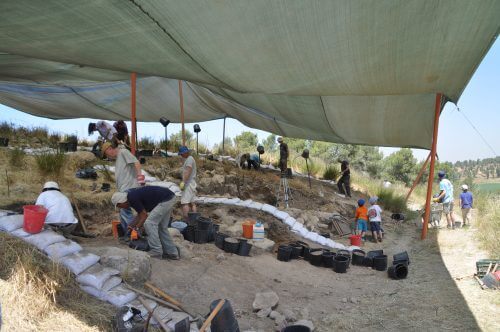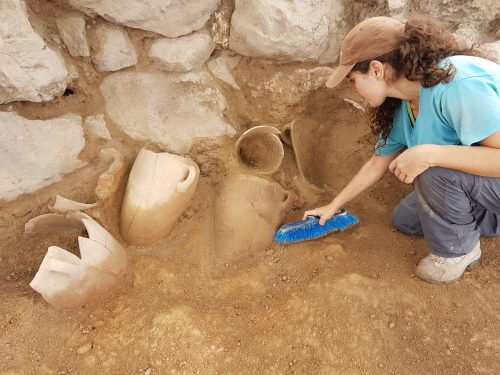The site, from the time of King David, was uncovered near Kiryat Gat * According to the biblical story, David lived in Batzkalg when he escaped from King Saul, and from there he went up to be anointed king in Hebron * At the ancient site from 3,000 years ago, dozens of intact pottery vessels were uncovered
Has the biblical Tskeleg been found? Researchers from the Hebrew University in Jerusalem, the Antiquities Authority and McQuarrie University in Sydney, Australia, believe they have discovered near Kiryat Gat the famous Philistine city from the biblical stories. Tzkelg is mentioned in the Bible a large number of times in connection with David (in the books of Samuel XNUMX and Samuel XNUMX). According to the biblical story, Achish the king of Gath let David live in Tskleg when he escaped the king's punishment, and from Tskleg David left to be anointed king in Hebron. According to the scriptures, a dramatic event even took place in Betzkel, during which the Amalekites, desert nomads, raided the city, taking women and children captive.
The excavation, which began in 2015 at the Horbat al-Ra'i site in the Judean Lowlands - between Kiryat Gat and Lakish, was conducted in collaboration with Prof. Yosef Garfinkel, head of the Institute of Archeology of the Hebrew University of Jerusalem, Sa'ar Ganor from the Antiquities Authority and Prof. Kyle Keimer from McQuarrie University in Sydney, Australia. Joey Silver from Jerusalem, Aaron Levy from New Jersey, and the Roth family and Isaac Vakil from Sydney participated in the financing of the excavation. Since the excavation began until today, seven excavation seasons have been conducted, and large areas have been excavated - about 1,000 square meters, from which the new discovery from the days of David emerges.

The name Tskeleg is unusual in the treasury of the names of the Land of Israel because it is not a local Canaanite-Semitic name, but a Philistine name, given to the city by a foreign population, who immigrated to the Land of Israel from the area of Greece. To this day, proposals have been made to identify Tzkalg at several sites, such as at Tel Khalif near Kibbutz Lahav, at Tel Shera in the Western Negev, at Tel Sheva, and more. However, according to the researchers, "in all these sites no settlement sequence was found, which includes both a Philistine settlement and a settlement from the days of David. In Hurbat al-Ra'i, on the other hand, characteristics of both populations were found."
Evidence of settlement from the days of the Philistines, from the 11th-12th centuries BC, was found on the site: spacious and massive stone buildings were uncovered, including findings typical of the Philistine culture. A special find discovered are bowls and candles - offerings that were placed under the floors of the buildings in the belief that they would bring good luck in the construction of the building. In addition, stone tools and metal tools were found. Similar finds from this period were discovered in the past in the excavations of Ashdod, Ashkelon, Ekron and Gat, the cities of the Philistine rulers.
Above the remains of the Philistine settlement, a rural settlement was discovered from the time of King David - the beginning of the 10th century BC. The settlement came to an end in a fierce fire, which destroyed the buildings. Dozens of intact pottery were found in the various rooms. These vessels are identical to those found in the fortified Judean city of the ruins of Caiaphas discovered in the Judean Lowlands and identified with the biblical Shaareim. Testing using the carbon 14 method dates the site of Horbat al-Ra'i to the time of King David.

The great variety of pottery testifies to the daily life in the days of David. During the excavation, large quantities of medium and large jugs were discovered, which were used to store oil and wine. Dishes for serving food, jugs and bowls were also found, which were decorated in red, in a style called "wild green", typical of the days of David. After a 12-year regional archeological study in the Judean Lowlands, conducted by Prof. Garfinkel and Ganor, the settlement picture of Judea at the beginning of the royal period begins to emerge: the two settlements - Tzkelg and the ruin of Kiapha, are located on the western border of the kingdom. They sit on a lofty hill, overlooking the main road that passes between the land of the Philistines and Judah: the ruin of Kiyapa in the Elah Valley sits opposite the Gath of the Philistines, and the ruin of El-Rai, identified as Zkeleg, sits opposite Ashkelon. This geographical description echoes David's lamentation, in which he mourns the death of Saul and Jonathan in the battle with the Philistines: "Do not say in Gath, do not preach in the streets of Ashkelon."
More of the topic in Hayadan:
We will close an account like men/Dr. Yachiam Sorek
